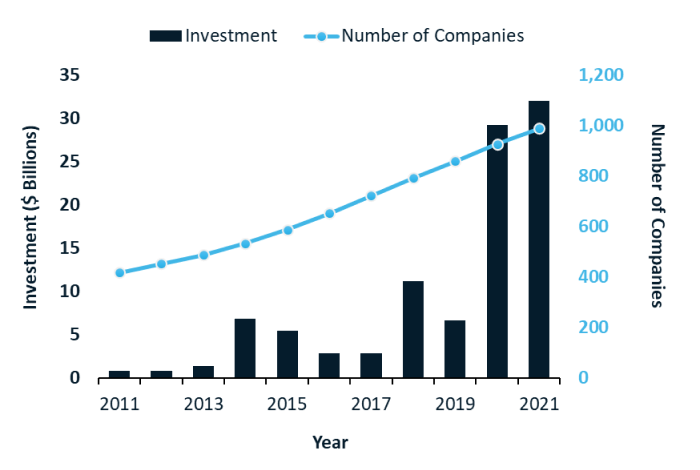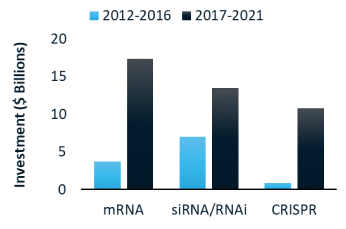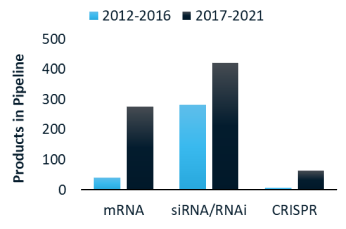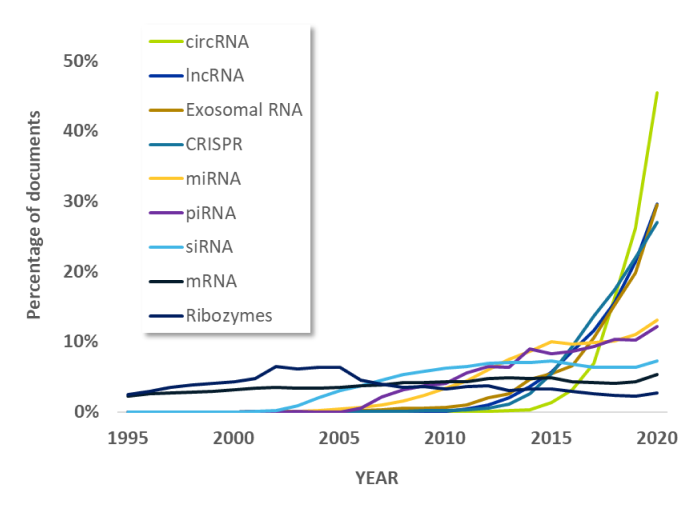Gain new perspectives for faster progress directly to your inbox.

Earlier this year we shared a collection of insights on RNA medicines, generated by a review of the scientific and patent literature. Since that time, we’ve looked into market trends in this space and, by combining insights gained from examining the CAS Content CollectionTM with data from PitchBook and Pharmaprojects, have been able to track what technological approaches and indications investors are backing.
Here are seven key takeaways from our analysis.
1. Investment has been intensifying in the past few years
A potential consequence of the success of the mRNA COVID vaccines is that the amount of investor funding flowing into RNA therapeutics and vaccines has skyrocketed since 2020 (Figure 1). The total number of companies has also risen, although not as sharply as the increase in investment, likely signaling increased funding at existing companies rather than through the creation of new companies (Figure 1).

2. Most investment is flowing into cancer R&D
We looked at which indications are receiving the most funding and found that the top investor-funded categories include cancer, infectious diseases, and liver and metabolic diseases. Not surprisingly, cancer is the lead indication for recent investment (Figure 2), which is reflective of the larger therapeutic R&D market. This is a slight change from the previous time period of 2012-2016, which showed that most investment was directed towards infectious diseases and liver/metabolic diseases.

Interestingly, despite the large increase in investment between these two time periods, the number of patents has not experienced as dramatic a rise (Figure 3), likely suggesting that much of the investment is focused on the development of existing patents rather than on the discovery of novel intellectual property.

3. Within cancer R&D, investment is split fairly evenly between mRNA, siRNA, and CRISPR approaches
Taking a closer look at the types of RNA being developed, we find that within cancer indications, funding is fairly evenly divided between mRNA, siRNAs, and CRISPR-based approaches (Figure 4). Note that we’ve included CRISPR under RNA therapeutics as the technology relies on guide RNA for targeting, even though some may consider it outside the category of RNA therapeutics.

4. Within infectious disease and liver/metabolic disease programs, mRNA is the preferred molecule
In contrast to projects developing anti-cancer treatments, projects targeting infectious diseases are primarily developing mRNA vaccines (Figure 4). The recent success of the mRNA COVID vaccines has highlighted the strength and speed of this approach for vaccine development and is likely the driving force behind the focus of mRNA in infectious diseases.
In liver and metabolic diseases, mRNA is also the preferred molecule for investment, although as of the writing of this article, the four US FDA-approved siRNA therapeutics—patisiran, givosiran, lumasiran, and inclisiran—all target the production of enzymes in the liver.
5. Recent investment across all indications primarily supports mRNA and siRNA, with more siRNA than mRNA products in the pipeline
Across all indications, mRNA is receiving the most investment (Figure 5A) and, while there were more siRNA products in the pipeline between 2017-2021 (Figure 5B), the situation has changed in 2022 with the number of mRNA products in the pipeline far surpassing the number of siRNAs, according to Pharmaprojects data.
However, combining this information with a review of the literature shows that more newly described forms of RNA such as circRNA, lncRNA, and exosomal RNAs are experiencing a rapid growth of interest (Figure 6). It will be interesting to see how much impact, if any, these newer types of RNA will have and how quickly they will move into development.
| A | B |
 |
 |
Figure 5. Recent investment primarily supports mRNA (A) whereas there are more siRNA products in the pipeline (B). (Data in A from Pharmaprojects and data in from PitchBook)

6. Most companies developing RNA products focus on a single type of RNA and target multiple indications
We looked at the top companies developing RNA therapeutics and found that, with the exception of AstraZeneca, each company focuses on developing a single type of RNA (Table 1) and applies their key technology to a range of indications (Table 2).
Table 1. Most companies focus on a single type of RNA
| mRNA | AstraZeneca BioNTech Cartesian Therapeutics Moderna Stemirna Therapeutics |
| ASO | AstraZeneca Ionis Pharmaceuticals Sarepta Therapeutics |
| siRNA | Alnylam Pharmaceuticals Arrowhead Pharmaceuticals AstraZeneca Dicerna Pharmaceuticals Silence Therapeutics Sirnaomics |
| Aptamer (RNA) | TME Pharma (formerly NOXXON Pharma) |
| miRNA | AstraZeneca |
| CRISPR | Beam Therapeutics CureVac |
Table 2. Most companies apply their technology to multiple indications.
| Alnylam Pharmaceuticals | Infectious, Neurological, Liver, Cancer, Kidney, Blood |
| Arrowhead Pharmaceuticals | Infectious, Neurological, Liver, Cancer |
| AstraZeneca | Cardiovascular, Liver, Metabolic, Cancer |
| Beam Therapeutics | Eye, Liver, Cancer, Blood |
| BioNTech | Infectious, Cancer |
| Cartesian Therapeutics | Neurological, Respiratory, Autoimmune, Cancer |
| CureVac | Infectious, Cancer |
| Dicerna Pharmaceuticals | Infectious, Liver, Alcohol Use Disorder, Kidney, Blood |
| Ionis Pharmaceuticals | Eye, Infectious Disease, Neuro, Liver, Acromegaly, Autoimmune, Cancer, Kidney, Blood |
| Moderna | Infectious, Cardiovascular, Liver, Autoimmune, Cancer |
| Sarepta Therapeutics |
Neuromuscular |
| Silence Therapeutics | Cardiovascular, Cancer, Blood |
| Sirnaomics | Infectious, Respiratory, Liver, Cancer, Blood |
| Stemirna Therapeutics | Infectious, Cancer |
| TME Pharma (formerly NOXXON Pharma) | Transplantation, Autoimmune, Cancer, Kidney, Blood |
7. Overall investment in RNA products was considerably reduced in 2022 compared to 2021
One interesting note about recent investment trends in RNA programs is that there was a significant reduction in overall investment in 2022 compared to 2021 (Figure 7). This reduction appears to be driven primarily by a decrease in the deal size of mergers and acquisitions (M&A), as the total number of M&As only decreased by about 2-fold.

Dig deeper into the science of what’s being funded
Increasing investment into RNA therapeutics has tremendous potential to deliver new options for currently untreatable diseases, especially in cancer, infectious diseases, liver and metabolic diseases, and rare diseases. However, many challenges still need to be overcome, especially around RNA stability, bioavailability, and tissue targeting. Find out more about commercialization challenges and the strategies being employed to overcome them in our white paper filled with insights from the CAS Content Collection, “RNA-Derived Medicines: A review of the research trends and developments.”



